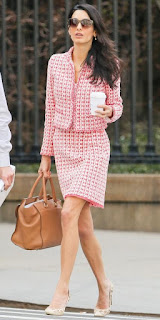AW TRENDS 2019- WOMEN
1. UNAPOLOGETC FLORALS
This season, florals are more extra than ever- including face masks - considered entirely viable options. Make like these high-end labels, and opt for styles with a muted base colour and bright, decorative petals splashed across.
2. WAIST BELTS
While a cinched waist is a timeless trait, it’s one which has fallen off the radar somewhat in high fashion circles due to the ever-growing fondness for a loose, undefined silhouette. Next season, however, it’s all change, and we’ll be reaching for our belts to wrap around everything, from knits to coats and everything in-between.
3. BROWN OUTERWEAR
If you had even half an eye on fashion week this season, you likely noticed the influx of tonal camel hues adorning the outfits of the street style set. Jump forward to the end of the year, and that same base shade gets an upgrade via sweeping midi coats.
4. CHECKS ON CHECKS
Last season saw clashing prints - think polka dots *with* stripes - prove popular, but next season the bold trend has been pared down to something somewhat more manageable. Essentially one single print, by autumn we'll all be re-investing in checks - we'll just be mixing the colours around a bit.
5. POINTED TOES
This season's footwear focus is all about the pointed toe.
6. THE NEW PUFFER
The puffer jackets is rarely off-the-menu right now, but just as it looked set to become a slightly stagnant market the off-duty look is entering new realms as next season it becomes a viable dressed-up option. Whether it's cropped and metallic, wrapped and tonal or mid-lenth and cinched, freezing temperatures will pose no problem on nights out next winter.
7. OTT FLUFF
If sequins aren't your thing, add a bit of zhush to your look with playful textures. I.e. extreme fluff. To go full-feather, you'll need to forgo any concerns for a sleek silhouette and embrace the bulk. Pair an OTT coat atop a chic slip for an impactful moment you can take off once inside, or go full-throttle with a feathered dress for drama all night long.
8. ARGYLE KNITS
Once the uniform of middle-aged golfers, argyle knitwear has had its highs and lows in the fashion world. But, according to this season's most popular runways, it's officially back in favour. Strictly saved for jumpers and cardigans, pair them with chic skirts for cozy days in the office.
9. GIANT BAGS
After seasons spent cramming only our very essential items into the teeniest, tiniest totes our phones would fit in, come autumn/winter our handbag-lip-balm-count will return to seven (minimum) as some of the coolest brands on the schedule dub it time to revisit practicality.
10. SEASONAL SPARKLE
2019's party season will welcome a whole host more sparkle. But unlike last year's sexy, almost predictable takes on the trend, next season sequins undertake a slightly more thoughtful aesthetic. From draped dresses to fringing and portraiture, Christmas-party-dressing looks set to be a whole lot more interesting.
AW TRENDS 2019-MEN
1. DENIM SUITS
For Autumn Winter ‘19 suits are back, but not as you know it. On the first day of London Fashion Week Men’s there were countless two pieces which hit the runways, but the majority were cut from denim rather than flannel.
2. OVERSIZED TRENCH COATS
For AW’19 the best takes include an oversized leather trench at John Lawrence Sullivan, a series of classic gabardine trenches in drapey proportions at wood wood, E Tautz and Daniel Fletcher; and our personal favourite, a series of neon taped, inside out-looking trench coats, neatly belted at the waist to balance their voluminous proportions, at Pronounce - the AW’19 show from the latter being a Saturday at LFWM highlight. Kent & Curwen's oversized trenches had a particularly preppy-meets-One Fine Day appeal, which felt surprisingly fresh.
3. HARRY POTTER SCARVES
Ultra-thick and looking as though they’ve been knitted by nanas, the big accessory trend for Autumn Winter ‘19 is for massively oversized scarves a la Harry Potter.
4. SPLIT LEG TROUSERS
Wide leg trousers with popper bottoms, are all the range for Autumn Winter ‘19. Designed to create a cleaner break when wearing a trouser with a wider base, this style works particularly worn with western boots.
5. MAN SKIRTS
Instead of two tubes of fabric, one sheathing each leg, for AW’19 London’s menswear designers have opted for a singular cylinder of fabric, otherwise known as a skirt for men.
6. LONG LINE PUFFER JACKETS
7. FUNERAL SUITS
Less silver service trainee, more mafioso at a funeral, slim-cut black tailoring a la Hedi Slimane’s heyday at Dior Homme was everywhere - particularly in Milan - this season.
8. LEOPARD PRINTS
For AW’19 leopard print was everywhere - from bright day-glo takes on the style, shown in fleeces at MSGM, to shaggy leopard coats at Versace, Celine, Dior and Marni, to that leopard print tuxedo at Philipp Plein.
9. VELVET
There was velvet a-plenty in Milano, from the classic tuxedos shown at Dolce & Gabbana, to the velvet suits (teamed with velvet shirts and velvet ties) at Ralph - and not forgetting the incredibly beautiful velvet suit jackets at Norbert Stumfl’s new Brioni and the host of deliciously syrupy velvet bombers and wide legged trousers at Emporio Armani, the key to wearing the trend is, well, to wear it head to toe.
10. BLACK BOVVER BOOTS
Heavy duty black boots are the biggest news for AW19, shoe-wise, and the trend is incredibly easy to absorb into your wardrobe.



























































